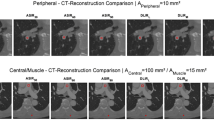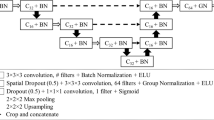Abstract
Purpose
To assess quantitative lobar pulmonary perfusion on DECT-PA in patients with and without pulmonary embolism (PE).
Materials and methods
Our retrospective study included 88 adult patients (mean age 56 ± 19 years; 38 men, 50 women) who underwent DECT-PA (40 PE present; 48 PE absent) on a 384-slice, third-generation, dual-source CT. All DECT-PA examinations were reviewed to record the presence and location of occlusive and non-occlusive PE. Transverse thin (1 mm) DECT images (80/150 kV) were de-identified and exported offline for processing on a stand-alone deep learning–based prototype for automatic lung lobe segmentation and to obtain the mean attenuation numbers (in HU), contrast amount (in mg), and normalized iodine concentration per lung and lobe. The zonal volumes and mean enhancement were obtained from the Lung Analysis™ application. Data were analyzed with receiver operating characteristics (ROC) and analysis of variance (ANOVA).
Results
The automatic lung lobe segmentation was accurate in all DECT-PA (88; 100%). Both lobar and zonal perfusions were significantly lower in patients with PE compared with those without PE (p < 0.0001). The mean attenuation numbers, contrast amounts, and normalized iodine concentrations in different lobes were significantly lower in the patients with PE compared with those in the patients without PE (AUC 0.70–0.78; p < 0.0001). Patients with occlusive PE had significantly lower quantitative perfusion compared with those without occlusive PE (p < 0.0001).
Conclusion
The deep learning–based prototype enables accurate lung lobe segmentation and assessment of quantitative lobar perfusion from DECT-PA.
Key Points
• Deep learning–based prototype enables accurate lung lobe segmentation and assessment of quantitative lobar perfusion from DECT-PA.
• Quantitative lobar perfusion parameters (AUC up to 0.78) have a higher predicting presence of PE on DECT-PA examinations compared with the zonal perfusion parameters (AUC up to 0.72).
• The lobar-normalized iodine concentration has the highest AUC for both presence of PE and for differentiating occlusive and non-occlusive PE.





Similar content being viewed by others
Abbreviations
- ANOVA:
-
Analysis of variance
- AUC:
-
Area under the curve
- CT:
-
Computed tomography
- CTEPH:
-
Chronic thromboembolic pulmonary hypertension
- DECT:
-
Dual-energy computed tomography
- DECT-PA:
-
Dual-energy computed tomography pulmonary angiography
- FOV:
-
Field of view
- HU:
-
Hounsfield units
- IRB:
-
Institutional review board
- PBV:
-
Perfused blood volume
- PE:
-
Pulmonary embolism
- ROC:
-
Receiver operating characteristics
References
Centers for Disease Control and Prevention (2019) Data and statistics on venous thromboembolism. Available via https://www.cdc.gov/ncbddd/dvt/data.html. Accessed on 24 June 2019
Thieme SF, Meinel FG, Graef A, Helck AD, Reiser MF, Johnson TR (2014) Dual-energy CT pulmonary angiography in patients with suspected pulmonary embolism: value for the detection and quantification of pulmonary venous congestion. Br J Radiol 87(1039):20140079
Lu GM, Wu SY, Yeh BM, Zhang LJ (2010) Dual-energy computed tomography in pulmonary embolism. Br J Radiol 83(992):707–718
Renapurkar RD, Bolen MA, Shrikanthan S et al (2018) Comparative assessment of qualitative and quantitative perfusion with dual-energy CT and planar and SPECT-CT V/Q scanning in patients with chronic thromboembolic pulmonary hypertension. Cardiovasc Diagn Ther 8(4):414–422
Zhang LJ, Zhou CS, Schoepf UJ et al (2013) Dual-energy CT lung ventilation/perfusion imaging for diagnosing pulmonary embolism. Eur Radiol 23(10):2666–2675
Alis J, Latson LA Jr, Haramati LB, Shmukler A (2018) Navigating the pulmonary perfusion map: dual-energy computed tomography in acute pulmonary embolism. J Comput Assist Tomogr 42(6):840–849
Thieme SF, Becker CR, Hacker M, Nikolaou K, Reiser MF, Johnson TR (2008) Dual energy CT for the assessment of lung perfusion–correlation to scintigraphy. Eur J Radiol 68:369–374
Singh R, Sharma A, McDermott S et al (2019) Comparison of image quality and radiation doses between rapid kV-switching and dual-source DECT techniques in the chest. Eur J Radiol 119:108639
Sakamoto A, Sakamoto I, Nagayama H, Koike H, Sueyoshi E, Uetani M (2014 Aug) Quantification of lung perfusion blood volume with dual-energy CT: assessment of the severity of acute pulmonary thromboembolism. AJR Am J Roentgenol 203(2):287–291
Novak CL, Odry BL, Kiraly AP, Wang J (2019) US Patent Application Publication. US 2019/0220701 A1. 2019;1–6. Available via http://www.freepatentsonline.com/20190220701.pdf. Accessed on 25 Oct 2019
Park J, Yun J, Kim N et al (2019) Fully automated lung lobe segmentation in volumetric chest CT with 3D U-net: validation with intra- and extra-datasets. J Digit Imaging. https://doi.org/10.1007/s10278-019-00223-1
Tang H, Zhang C, Xie X (2019) Automatic pulmonary lobe segmentation using deep learning. ArXiv:1903.09879 [Cs]. http://arxiv.org/abs/1903.09879. Accessed on 25 Oct 2019
Miniati M, Monti S, Bottai M et al (2006) Survival and restoration of pulmonary perfusion in a long-term follow-up of patients after acute pulmonary embolism. Medicine (Baltimore) 85(5):253–262
Azarian R, Wartski M, Collignon MA et al (1997) Lung perfusion scans and hemodynamics in acute and chronic pulmonary embolism. J Nucl Med 38(6):980–983
Im DJ, Hur J, Han KH et al (2017) Acute pulmonary embolism: retrospective cohort study of the predictive value of perfusion defect volume measured with dual-energy CT. AJR Am J Roentgenol 209(5):1015–1022
Masy M, Giordano J, Petyt G et al (2018) Dual-energy CT (DECT) lung perfusion in pulmonary hypertension: concordance rate with V/Q scintigraphy in diagnosing chronic thromboembolic pulmonary hypertension (CTEPH). Eur Radiol 28(12):5100–5110
Sueyoshi E, Tsutsui S, Hayashida T, Ashizawa K, Sakamoto I, Uetani M (2011) Quantification of lung perfusion blood volume (lung PBV) by dual-energy CT in patients with and without pulmonary embolism: preliminary results. Eur J Radiol 80(3):e505–e509
Okada M, Nomura T, Nakashima Y, Kunihiro Y, Kido S (2018) Histogram-pattern analysis of the lung perfused blood volume for assessment of pulmonary thromboembolism. Diagn Interv Radiol 24(3):139–145. https://doi.org/10.5152/dir.2018.17311
Nallasamy N, Bullen J, Karim W, Heresi GA, Renapurkar RD (2018) Evaluation of vascular parameters in patients with pulmonary thromboembolic disease using dual-energy computed tomography. J Thorac Imaging. https://doi.org/10.1097/RTI.0000000000000383
Ameli-Renani S, Rahman F, Nair A et al (2014) Dual-energy CT for imaging of pulmonary hypertension: challenges and opportunities. Radiographics. 34(7):1769–1790
Otrakji A, Digumarthy SR, Lo Gullo R, Flores EJ, Shepard JA, Kalra MK (2016) Dual-Energy CT: Spectrum of thoracic abnormalities. Radiographics. 36(1):38–52
Funding
The authors state that this work has not received any funding.
Author information
Authors and Affiliations
Corresponding author
Ethics declarations
Guarantor
The scientific guarantor of this publication is Mannudeep K Kalra.
Conflict of interest
Two authors (Bernhard Schmidt and Thomas Flohr) are employees of Siemens Healthcare. One author (Mannudeep K. Kalra) has received research grant from Siemens Healthineers. The remaining authors declare no relationships with any companies whose products or services may be related to the subject matter of the article.
Statistics and biometry
No complex statistical methods were necessary for this paper.
Informed consent
Written informed consent was waived by the Institutional Review Board.
Ethical approval
Institutional Review Board approval was obtained.
Methodology
• Retrospective
• Observational
• Performed at one institution
Additional information
Publisher’s note
Springer Nature remains neutral with regard to jurisdictional claims in published maps and institutional affiliations.
Rights and permissions
About this article
Cite this article
Singh, R., Nie, R.Z., Homayounieh, F. et al. Quantitative lobar pulmonary perfusion assessment on dual-energy CT pulmonary angiography: applications in pulmonary embolism. Eur Radiol 30, 2535–2542 (2020). https://doi.org/10.1007/s00330-019-06607-9
Received:
Revised:
Accepted:
Published:
Issue Date:
DOI: https://doi.org/10.1007/s00330-019-06607-9




